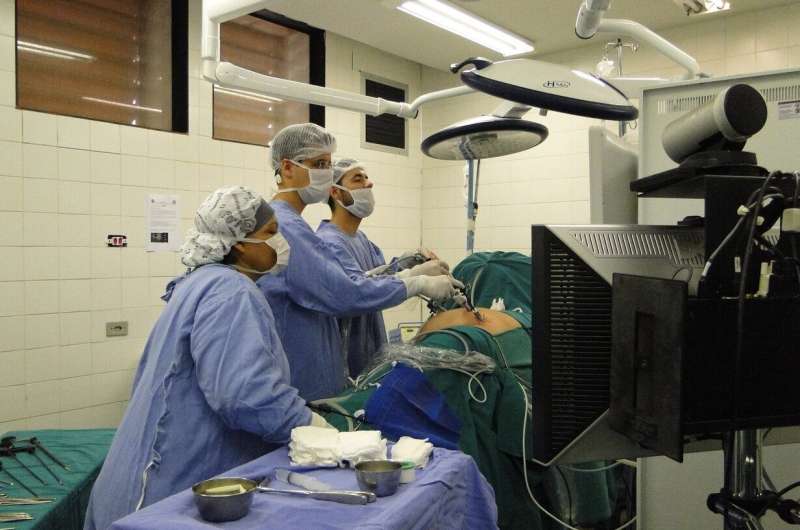This article has been reviewed according to Science X's editorial process and policies. Editors have highlighted the following attributes while ensuring the content's credibility:
fact-checked
trusted source
written by researcher(s)
proofread
An oncologist explains why some cancer patients receive both chemotherapy and surgery

When Kate Middleton, the princess of Wales, announced in March 2024 that she was receiving "preventive chemotherapy" following abdominal surgery, many wondered what that entails. Formally known as adjuvant therapy, administering chemotherapy or other treatments after surgery is a common approach to treating certain types of cancer and is not necessarily intended to prevent cancer.
Oncologist Alexander Olawaiye of the University of Pittsburgh explains what factors doctors take into account when devising a cancer treatment plan.
Why are some cancers treated with surgery but not others?
There are many types of cancer treatment, including surgery, chemotherapy, radiotherapy, immunotherapy, and hormonal therapy, among others. Sometimes, doctors combine multiple types of treatment. Which is the best treatment approach depends on which organ the tumor originated from and how much the tumor has spread at the time of diagnosis.
Broadly speaking, there are two types of cancers: solid tumors—or visible tumors that can be seen by the naked eye or through imaging—and liquid tumors, such as blood cancers. The primary treatment for solid cancers is surgery to physically remove the tumor, with the goal of getting rid of all tissues involved with the tumor.
For example, in ovarian cancer, surgery often includes removing the ovaries, fallopian tubes and the uterus, along with any visible cancer tissue in the rest of the belly. Sometimes this requires removing the spleen or part of the small intestine or liver.
For skin cancers such as melanoma, surgery involves removing both the tumor and a good margin of normal-looking skin with it to capture any remaining cancer cells that may not be visible in the surrounding healthy skin. Likewise, a surgeon may also remove nearby lymph nodes.
When solid cancer is diagnosed early, the success of treatment following surgery is typically high. For example, an estimated 91% of cervical cancer patients who are diagnosed early are still alive at least five years after diagnosis. Endometrial cancer patients who are diagnosed early have an estimated five-year survival rate of 95%.
Why do some cancers recur?
Despite surgical removal, many tumors come back. Researchers don't fully understand why cancers recur, but there are certain red flags that indicate the potential for recurrence.
One is how different the cancer cells look compared with healthy cells. The more different, the more aggressive the tumor. When a tumor is more aggressive, it's more likely to invade neighboring tissues and spread to other parts of the body.
Another is the extent the cancer has spread at the time of diagnosis. This is what determines the stage of the cancer. For example, stage 1 cancer refers to a tumor that is confined to the organ it originally developed from. Stage 4 cancer refers to a tumor that has spread far from its origins to grow on other organs. The higher the stage, the higher the risk for a worse outcome.
A third factor is the organ where the cancer first originated. For instance, pancreatic cancers tend to be fatal even when diagnosed early because these tumors don't respond well to therapy. Ovarian cancer can have symptoms that are difficult to recognize, leading to late diagnoses. On the other hand, breast cancer and thyroid cancer tend to be less aggressive for longer periods of time, even when diagnosed at an advanced stage.
What is adjuvant and neoadjuvant therapy?
For patients with tumors that can be surgically removed, they often also receive chemotherapy or radiotherapy before or after the procedure. Doctors prescribe this additional, or adjuvant, treatment depending on the patient's risk of recurrence.
Recurrence typically happens when cancer cells escape from the tumor prior to or during surgical removal. Adjuvant chemotherapy or radiation after the procedure is aimed at killing these cells so they don't settle down and grow somewhere else in the body later on.
In some cases, surgical removal is not feasible or not advisable. This could be because the cancer has spread so much that completely cutting it out is impossible or the risk of complications or disability from the surgery is high.
For example, primary surgery often isn't a good option for ovarian cancer, since most patients are diagnosed in advanced stages; complete surgical removal, even if possible, may involve removing important organs such as the rectum and colon. This can lead to the need for a colostomy or ileostomy, where stool is passed directly from the large or small intestine to a bag outside the belly. Surgical removal of breast cancer may mean losing the affected breast.
The risk of unwanted side effects from surgical removal can be reduced through neoadjuvant therapy, or administering chemotherapy or radiation before the procedure to shrink the tumor and reduce the amount of surgery required. Studies have shown that neoadjuvant therapy can help ovarian cancer patients avoid colostomies after surgery and allow breast cancer patients to opt for a procedure that conserves their breast.
Neoadjuvant or adjuvant treatment can include chemotherapy, immunotherapy, hormonal therapy, radiation therapy or a combination of these treatments. Further advances in research will offer doctors and patients even more approaches to effectively treat cancer.
This article is republished from The Conversation under a Creative Commons license. Read the original article.![]()




















